25 Latest Gig Economy Statistics For 2024 (Industry Data)

Curious to know more about the state of the gig economy?
In this post, we share the latest gig economy statistics that showcase how much gig workers make, who gig workers are and more.
We’ve organized these stats into a few different lists, including general gig economy statistics, revenue-based stats, online gig platform stats and more.
Gig economy statistics – editor’s picks
The top five most essential gig economy statistics:
- There are more than 70.4 million freelance workers in the United States. (Statista1)
- 80% of gig workers report being satisfied with their work. (Skynova)
- 46% of gig workers in the United States belong to the Millennial age group. (Statista2)
- 56% of gig workers use their income from gig economy jobs as a way to put money toward their savings. (Statista4)
- The majority of gig workers, or 38%, earn $10 to $14.99/hour. (Economic Policy Institute)
General gig economy statistics
1. There was 70.4 million freelancers in the United States in 2022
According to data published by Statista, there were 70.4 million freelancers working in the United States in 2022, up from 67.6 million in 2021.
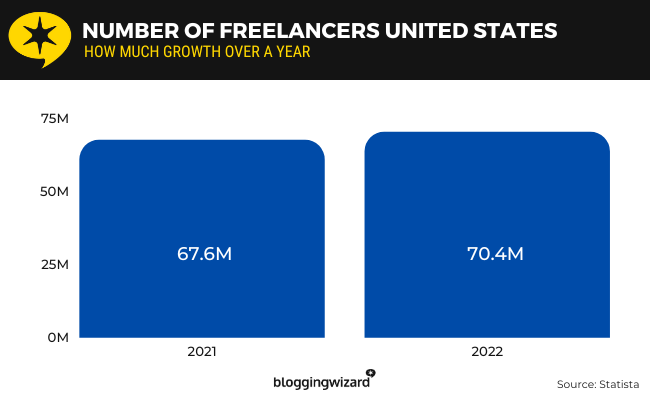
According to the stat’s estimate, there will be more than 90 million freelancers working in the United States by 2028.
This will make up more than 50% of the workforce in the United States.
Source: Statista1
2. 80% of gig workers are satisfied with their work
Skynova conducted a survey of 1,000 gig workers.
80% of respondents to that survey reported being satisfied with their work, meaning 20% of gig workers, or 1 in 5 of gig workers, are unsatisfied with gig work.
85% of respondents who reported being satisfied with their jobs were men while 72% were women.

65% are satisfied with their payment while 55% are satisfied with their work-life balance.
The age group who are most satisfied with gig work is Gen Z.
Lyft drivers are most satisfied overall as 90% report being satisfied with their work. In fact, Lyft drivers are 12% more likely to be satisfied with their jobs from a work-life balance perspective than Uber drivers.
Source: Skynova
3. 96% of gig workers want a permanent job
Skynova’s data revealed an interesting statistic.
While 80% of gig workers are satisfied with gig economy work, 96% want permanent jobs.

However, 91% are having trouble finding permanent jobs while 74% turned to gig work after being laid off.
Source: Skynova
4. 26% of gig workers are overworked
Skynova asked gig workers about the challenges they face in the gig economy.
26% of respondents, or the majority, say they are overworked.
All other challenges were voted for by 21-23% of respondents.
They are:
- Lack of job security – 23% report this as being a challenge they face.
- Lack of benefits or health insurance – 23%.
- No career resources – 23%.
- Irregular wages – 22%.
- Insufficient workload – 22%.
- Unpaid invoices* – 22%.
- Fear of running out of money – 21%.
- Living paycheck to paycheck – 21%.
- Uncertainty about future income – 21%.
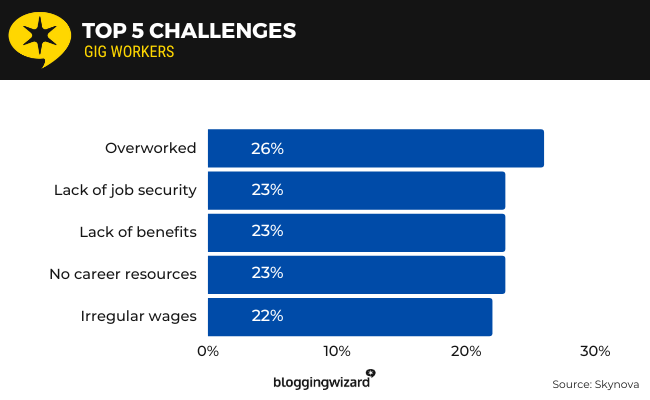
For men, the top three challenges of gig work are being overworked (voted for by 24% of men), having no access to benefits (21%) and living paycheck to paycheck (21%).
For women, the top three challenges of gig work are being overworked (voted for by 32% of women), having an insufficient workload (31%) and a lack of job security (29%).
*Speaking of unpaid invoices, gig workers say they are awaiting $4,723 from invoices overall.
Men have $5,910 in unpaid invoices while women have $3,153.
Source: Skynova
5. 75% of gig workers have two or more gig jobs
Skynova’s survey of gig workers revealed that 75% of workers who work gig jobs do so while working two or more gig jobs.
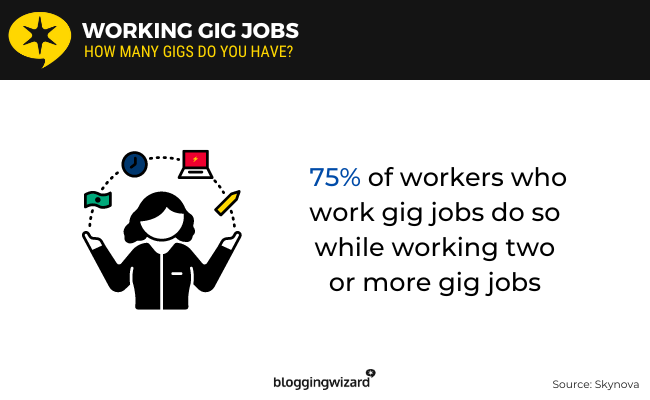
This is a great example of the flexibility gig work provides.
Source: Skynova
6. 46% of gig economy workers in the United States are millennials
According to data obtained by Statista, 46% of freelancers in the United States belong to the Millennial age group, which consists of individuals born in or between 1981 and 1995.
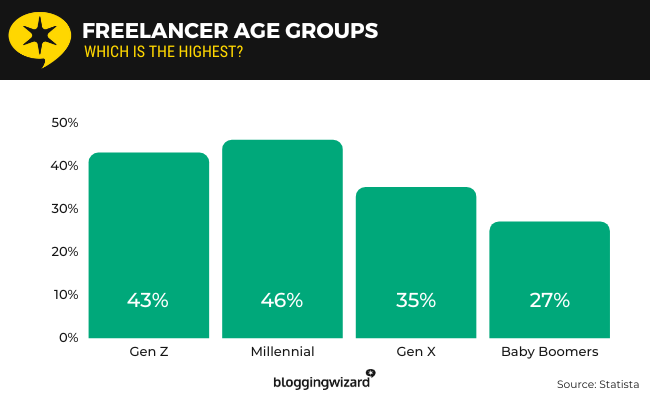
43% belong to Gen Z, or individuals born in or between 1996 and 2010.
35% belong to the Gen X age group, or individuals born in or between 1965 and 1980.
The remaining 27% are from generations born before 1965.
Source: Statista2
7. 51% of freelancers in the United States have a postgraduate degree
According to an analysis of the education levels of freelance workers, 51% of gig workers in the United States have a postgraduate degree of some kind.
These include master’s degrees and Phds.

35% have a bachelor’s degree while another 35% have some college experience or an associates degree, at the very least.
31% have a high school diploma or never graduated high school at all.
Source: Statista3
8. 56% of gig workers in the United States use the extra income to establish a savings fund
According to a survey of gig workers who earned an income from gig jobs over a 12-month period, 56% reported using gig work as a way to save money while they used a traditional job to cover living expenses and wants.
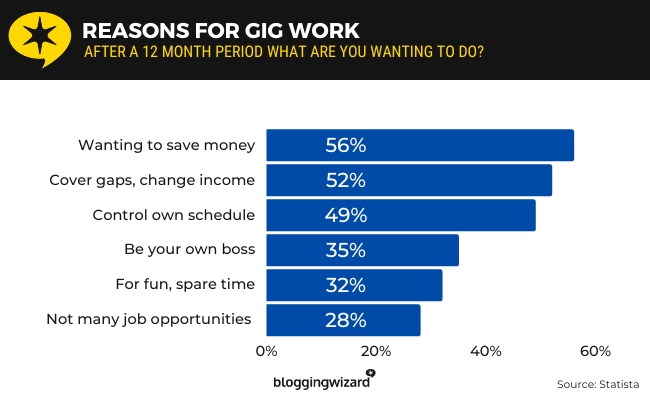
Here are other reasons cited in this survey:
- Cover gaps in income – 52% of gig workers report this as their reason for working in the gig economy.
- Flexible schedule – 49%
- No boss – 35%
- To fill spare time – 32%
- Lack of local job opportunities – 28%
Similarly, 58% of gig workers reported gig work as being an important source of income for meeting their basic needs with 23% saying it’s a primary source of income (“essential”).
A separate survey, which was published by Statista in cooperation with McKinsey & Company, revealed that 25.7% of independent workers use gig work “out of a necessity to support basic family needs.”
24.9% like the flexibility gig work provides while 24.7% genuinely like the work.
This survey revealed that only 19.5% of gig workers use gig work as disposable income.
If we take this statistic a bit further, we discover that, according to a separate survey that consisted of 1,100 participants, 62% of gig workers say they don’t have an emergency savings fund that would sustain them for six months.
24% do not have an emergency savings fund that would last a single month.
Source: Statista4, Statista5, Statista6, Statista7
Revenue-based gig economy statistics
9. Revenue from the global gig economy is expected to reach $455.2 billion in 2023
According to economic forecasts, the global gig worker economy is expected to reach a total volume of $455.2 billion by the end of 2023.
This data includes freelancer income from gig-based apps and platforms.
Source: Statista8
10. 38% of gig workers earn $10.00 to $14.99/hour
According to a survey conducted by EPI, 38% of gig workers report earning between $10 and $14.99/hour.
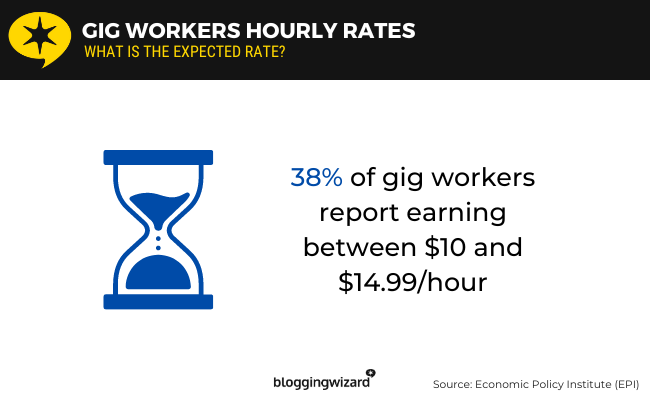
This is in comparison to the 53% of W2 service-sector employees who earn the same rate.
24% of gig workers earn $15 to $20.99/hour, 14% earn less than $7.25/hour (lower than the legal minimum wage), 13% earn $21/hour or more, and 12% earn $7.25 to $9.99/hour.
Respondents to EPI’s survey consisted of 288 gig workers and 4,201 W2 service-sector employees.
The survey was conducted in May of 2020 but was published in June 2022.
Source: Economic Policy Institute (EPI)
11. The percentage of gig workers earning more than $100,000/year increased by 62.96% between 2011 and 2022
Statista collects data on the percentage of freelancers who earn more or less than $100,000/year from freelance work.
Their data reveals that 12.5% of freelancers earned over $100,000/year in 2011.
That number increased to 20.37% by 2022, a 62.96% increase from 2011’s share.
Source: Statista9
12. 65% of gig workers earn more freelancing than they did with traditional employment
According to a survey, the data of which was published by Statista, 65% of gig workers report earning more as freelancers than they did with their traditional jobs.
This data comes from a survey that received more than 6,000 respondents.
Source: Statista10
13. The highest-paying gig job is a massage therapist at an hourly rate of $27.84
According to data on the highest-paying gig jobs, the highest-paying gig job is a massage therapist, who earns $27.84/hour.
The data also cites freelance cleaning-based jobs, which has an hourly rate of $11.29.
Source: Statista11
14. 45% of freelancers in the United States are paid via a fixed payment structure
According to a survey of over 6,000 gig workers, 45% of gig workers in the United States are paid on a fixed payment structure rather than an hourly rate.
Source: Statista12
App-related gig economy statistics
15. Uber has more than 100 million downloads on Google Play
Uber is the most popular app for gig workers by far.
The driver version of the app has more than 100 million downloads on Google Play and a 4.5-star rating out of over 3.45 million reviews.
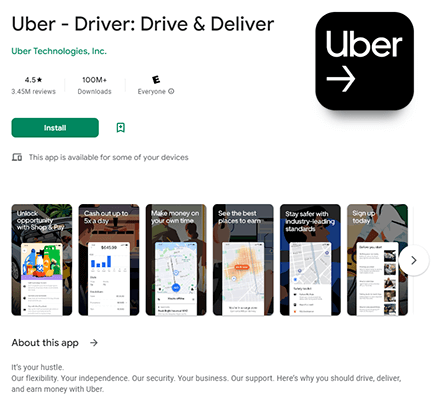
It has a 4.6-star rating out of over 590,000 reviews on the App Store.
After that, the most popular app is food delivery-based app DoorDash, which has over 10 million downloads and a 4.3-star rating out of over 199,000 reviews.
The app has a 4.7-star rating out of over 2.7 million reviews on the App Store.
Source: Google Play1, App Store1, Google Play2, App Store2
16. Uber drivers make $19.17/hour on average in the United States
According to data from over 300 salary profiles for Uber drivers on Indeed, the average Uber driver makes $19.17/hour, which works out to an annual salary of $63,418.
According to Indeed’s data, this is 16% above the national average for this type of work.
Drivers make only $7.25/hour on the low end of the scale and as much as $39/hour on the high end.
It should be noted that Uber takes a 25% cut on all fares (but never on tips, 100% of which go to drivers), and because they don’t withhold tax, drivers are considered independent contractors and must pay a self-employment tax on all earnings in addition to their regular income tax.
At a salary of $63,418/year, that works out to a tax rate of 37.3% before deductions, which vary greatly between drivers.
Source: Indeed1
17. DoorDash drivers make $15.96/hour on average in the United States
This data comes from over 1,400 salary profiles on Indeed.
The average DoorDash driver makes an hourly rate of $15.96, which works out to an annual salary of $58,932.
This is 15% above the national average.
Drivers make between $7.25 and $32.50/hour.
Drivers are paid a base rate per order, which can be as low as $2 or higher than $10. The amount is dependent on how far the driver has to drive to complete the order and the estimated amount of time the order will take.
Like Uber, DoorDash does not take a cut from tips.
Source: Indeed2
18. Uber generated more than $31.9 billion in 2022
According to financial reports Uber publishes quarterly and on an annual basis, the company generated $31.877 billion in 2022.
This was an 83% increase from 2021’s revenue, which was $17.5 billion.
Source: Uber
19. Upwork had 814,000 active clients in 2022
In Upwork’s annual report, the company reported an active client base of 814,000 throughout 2022, a 6% increase from 2021’s 771,000 active client base.
Source: Upwork
20. The Upwork platform accumulated $4.1 billion in gross sales in 2022
Upwork reported a 16% increase in gross sales in 2022.
While 2021 saw $3.5 billion in gross sales, the platform generated $4.1 billion in 2022.
However, it should be noted that the platform’s growth rate in this department has dropped considerably as gross sales increased by 41% between 2020 and 2021 but only 16% between 2021 and 2022.
Marketplace revenue was $566 million in 2022, an increase of 23% from 2021’s $462 million.
Source: Upwork
21. Fiverr has 133 million user accounts
According to Fiverr’s annual report for 2022, which they filed in early 2023, the company had a total of 133 million user accounts by the end of 2022.
They had over 118 million user accounts by the end of 2021.
Source: Fiverr
22. Fiverr’s revenue was $337 million in 2022
When Fiverr published their annual report for shareholders, they revealed that the platform generated $337 million in revenue in 2022, up from $297 million in 2021 and $189 million in 2020.
Their cost of revenue was $65 million, which made for a gross profit of $271 million.
Source: Fiverr
Misc. gig economy statistics
23. 62% of gig workers have lost pay due to technical issues with clocking in or out
EPI’s survey revealed that 62% of gig workers reported losing pay due to technical issues that occurred while clocking in or out of work at least once.

This is in comparison to the 19% of service-sector employees who have experienced the same issue.
36% of gig workers said this has happened three or more times, compared to the 8% of service-sector employees who reported the same.
Source: Economic Policy Institute
24. 38% of gig workers expect technology to play a bigger role in the gig economy in 2023
Skynova asked gig workers about their predictions for 2023.
38% of gig workers predict that technology will play a much larger role in gig work this year.
37% expect gig workers to have higher incomes, 36% predict the number of gig workers to grow and 36% expect gig workers to be better educated.
Source: Skynova
25. 66% of gig workers plan to take on more work
Skynova asked gig workers whether or not they plan on taking more gig work in 2023.
66% said they plan on taking more gig work in 2023 while 23% will take on less.
12% will take on the same amount of gig work as they did in the previous year.
As for how workers feel about their current gigs, 85% reported feeling optimistic while heading into the new year.
72% believed they would make more money.
73% of gig workers will keep their current gigs for at least one more year while 27% quit within the first couple of months of 2023.
Source: Skynova
Gig economy statistics sources
Final thoughts
That concludes our list of the latest gig economy statistics.
They prove just how much the industry is growing and open your eyes to the balancing act that is independent work.
While a decent number of gig workers make more than $100,000/year, it seems the majority of workers make just above the federal poverty line.
Even worse, while full-time gig workers are out there, many gig workers work gig jobs on the side of their day jobs out of necessity.
Be sure to read our related stats posts for more statistics on this type of work.
Related reading:
